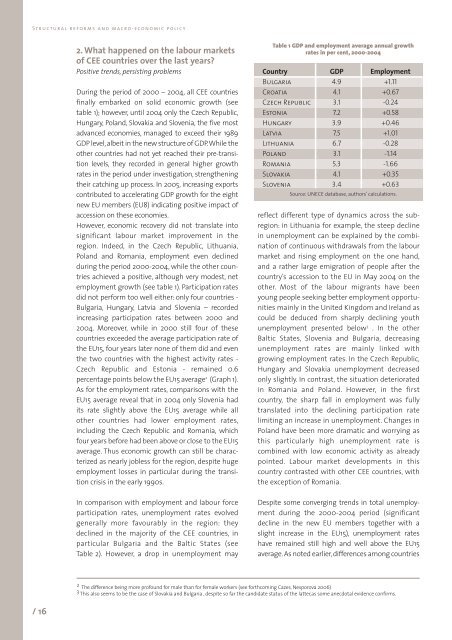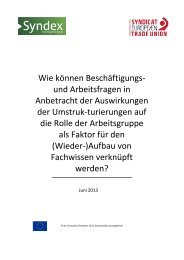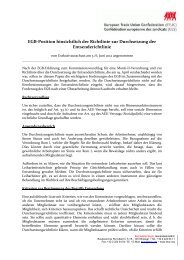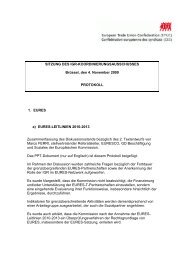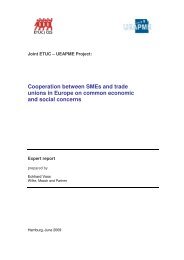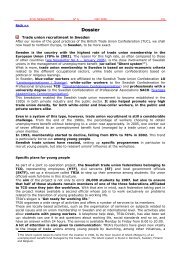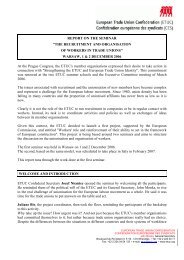Structural reforms and macro-economic policy - ETUC
Structural reforms and macro-economic policy - ETUC
Structural reforms and macro-economic policy - ETUC
Create successful ePaper yourself
Turn your PDF publications into a flip-book with our unique Google optimized e-Paper software.
<strong>Structural</strong> <strong>reforms</strong> <strong>and</strong> <strong>macro</strong>-<strong>economic</strong> <strong>policy</strong><br />
/ 16<br />
2. What happened on the labour markets<br />
of CEE countries over the last years?<br />
Positive trends, persisting problems<br />
During the period of 2000 – 2004, all CEE countries<br />
finally embarked on solid <strong>economic</strong> growth (see<br />
table 1); however, until 2004 only the Czech Republic,<br />
Hungary, Pol<strong>and</strong>, Slovakia <strong>and</strong> Slovenia, the five most<br />
advanced economies, managed to exceed their 1989<br />
GDP level, albeit in the new structure of GDP.While the<br />
other countries had not yet reached their pre-transition<br />
levels, they recorded in general higher growth<br />
rates in the period under investigation, strengthening<br />
their catching up process. In 2005, increasing exports<br />
contributed to accelerating GDP growth for the eight<br />
new EU members (EU8) indicating positive impact of<br />
accession on these economies.<br />
However, <strong>economic</strong> recovery did not translate into<br />
significant labour market improvement in the<br />
region. Indeed, in the Czech Republic, Lithuania,<br />
Pol<strong>and</strong> <strong>and</strong> Romania, employment even declined<br />
during the period 2000-2004, while the other countries<br />
achieved a positive, although very modest, net<br />
employment growth (see table 1). Participation rates<br />
did not perform too well either: only four countries -<br />
Bulgaria, Hungary, Latvia <strong>and</strong> Slovenia – recorded<br />
increasing participation rates between 2000 <strong>and</strong><br />
2004. Moreover, while in 2000 still four of these<br />
countries exceeded the average participation rate of<br />
the EU15, four years later none of them did <strong>and</strong> even<br />
the two countries with the highest activity rates -<br />
Czech Republic <strong>and</strong> Estonia - remained 0.6<br />
percentage points below the EU15 average 2 (Graph 1).<br />
As for the employment rates, comparisons with the<br />
EU15 average reveal that in 2004 only Slovenia had<br />
its rate slightly above the EU15 average while all<br />
other countries had lower employment rates,<br />
including the Czech Republic <strong>and</strong> Romania, which<br />
four years before had been above or close to the EU15<br />
average. Thus <strong>economic</strong> growth can still be characterized<br />
as nearly jobless for the region, despite huge<br />
employment losses in particular during the transition<br />
crisis in the early 1990s.<br />
In comparison with employment <strong>and</strong> labour force<br />
participation rates, unemployment rates evolved<br />
generally more favourably in the region: they<br />
declined in the majority of the CEE countries, in<br />
particular Bulgaria <strong>and</strong> the Baltic States (see<br />
Table 2). However, a drop in unemployment may<br />
Table 1 GDP <strong>and</strong> employment average annual growth<br />
rates in per cent, 2000-2004<br />
Country GDP Employment<br />
Bulgaria 4.9 +1.11<br />
Croatia 4.1 +0.67<br />
Czech Republic 3.1 -0.24<br />
Estonia 7.2 +0.58<br />
Hungary 3.9 +0.46<br />
Latvia 7.5 +1.01<br />
Lithuania 6.7 -0.28<br />
Pol<strong>and</strong> 3.1 -1.14<br />
Romania 5.3 -1.66<br />
Slovakia 4.1 +0.35<br />
Slovenia 3.4 +0.63<br />
Source: UNECE database, authors’ calculations.<br />
reflect different type of dynamics across the subregion:<br />
in Lithuania for example, the steep decline<br />
in unemployment can be explained by the combination<br />
of continuous withdrawals from the labour<br />
market <strong>and</strong> rising employment on the one h<strong>and</strong>,<br />
<strong>and</strong> a rather large emigration of people after the<br />
country’s accession to the EU in May 2004 on the<br />
other. Most of the labour migrants have been<br />
young people seeking better employment opportunities<br />
mainly in the United Kingdom <strong>and</strong> Irel<strong>and</strong> as<br />
could be deduced from sharply declining youth<br />
unemployment presented below 3 . In the other<br />
Baltic States, Slovenia <strong>and</strong> Bulgaria, decreasing<br />
unemployment rates are mainly linked with<br />
growing employment rates. In the Czech Republic,<br />
Hungary <strong>and</strong> Slovakia unemployment decreased<br />
only slightly. In contrast, the situation deteriorated<br />
in Romania <strong>and</strong> Pol<strong>and</strong>. However, in the first<br />
country, the sharp fall in employment was fully<br />
translated into the declining participation rate<br />
limiting an increase in unemployment. Changes in<br />
Pol<strong>and</strong> have been more dramatic <strong>and</strong> worrying as<br />
this particularly high unemployment rate is<br />
combined with low <strong>economic</strong> activity as already<br />
pointed. Labour market developments in this<br />
country contrasted with other CEE countries, with<br />
the exception of Romania.<br />
Despite some converging trends in total unemployment<br />
during the 2000-2004 period (significant<br />
decline in the new EU members together with a<br />
slight increase in the EU15), unemployment rates<br />
have remained still high <strong>and</strong> well above the EU15<br />
average. As noted earlier, differences among countries<br />
2 The difference being more profound for male than for female workers (see forthcoming Cazes, Nesporova 2006)<br />
3 This also seems to be the case of Slovakia <strong>and</strong> Bulgaria , despite so far the c<strong>and</strong>idate status of the latter,as some anecdotal evidence confirms.


